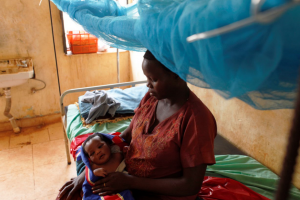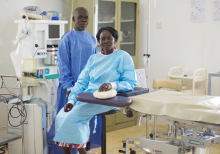Dynamic staff and sparkling maternity complex deliver improved maternal health in South Sudan
In the maternity unit at Wau Teaching Hospital in South Sudan’s Wau State, Angelina Bakhit gazes down at her new son, Mayen, thankful that the ordeal of labour is over.
Mayen is a big baby, and it was a difficult birth, requiring Bakhit to undergo a caesarean section.
“We thought at one point she might be having twins,” says midwife Viola James. “But the ultrasound confirmed just one baby – too large to deliver normally. We monitored her carefully during antenatal check-ups, and when she was in labour, our obstetrician carried out the operation.”
A year or more ago, the odds against Bakhit surviving were not at all in her favour. But now, with the concerted efforts of the Ministry of Health in South Sudan, supported by the World Health Organization (WHO), the Government of Canada and other partners, Wau Teaching Hospital is a shining example of how maternal and newborn health is being improved in the world’s youngest country.
Enthusiastic and newly trained medical staff are contributing a pivotal role.
Presiding over the Wau Teaching Hospital’s maternity complex is obstetrician and gynaecologist Dr William Musa. He recently returned to South Sudan from Tanzania where, with WHO and Government of Canada support, he was able to study for his postgraduate specialization.
South Sudan has one of the highest rates of maternal mortality globally, at a current estimate of 789 maternal deaths per 100 000 live births. One reason for this is the very low rate – about 12% – of hospital births. Persuading women to deliver their babies in clean facilities under the care of trained staff is extremely important in reducing mortality rates.
Since joining the Wau Teaching Hospital in May 2018, Dr Musa is delighted to report success in boosting the number of monthly hospital births by more than 60%, to 225 from 139. He also has increased the number of caesarean section surgeries performed per month by 40%, to 21 from nine. Obstructed labour is one of the top causes of maternal and child death, and a caesarean delivery can be a lifesaving procedure for mother and baby.
Dr Musa’s job attending to difficult labours has also become easier with the addition of a dedicated maternity operating theatre within an expanded maternity complex, built with funding from the Government of Canada and with the support of WHO.
“Before, if we had to do an emergency caesarean section, we had to use the hospital’s main operating theatre, which might not necessarily be available,” says Dr Musa. “Now, we can rush a patient directly to our dedicated theatre.”
The complex also includes a maternal waiting home, and this is helping to save the lives of women usually living in remote villages. At-risk women are invited to stay at the hospital for the last month or two of their pregnancy, where they are closely monitored and can transfer straight to the labour ward when ready, rather than find themselves stranded far from help.
In addition to the maternity complex in Wau, the Government of Canada has funded five others across the country.
“This kind of infrastructure development has resulted in access for a lot more people who didn’t otherwise have it before,” says James Christoff, Ambassador of Canada to South Sudan.
No maternal death reported
Since Dr Musa’s arrival seven months ago, the Wau Teaching Hospital has not experienced a single maternal death.
“This is a good improvement,” he says modestly.
The WHO Regional Director for Africa, Dr Matshidiso Moeti, firmly agrees.
“Building the capacity of medical experts to specialize in obstetrics and gynaecology illustrates the productive efforts that the Government of South Sudan has made, starting virtually from scratch at independence, to increase the numbers and skills of nurses, midwives and doctors available in the country,” she says.
The increase in births at the hospital means that Dr Musa’s midwife colleagues have much work on their hands.
“Sometimes we work double shifts without stopping for lunch,” says Viola James. Luckily, she loves her job, having become interested in midwifery as a teenager.
She was able to pursue her ambition after becoming one of the first students accepted into a new programme to train midwives. This scheme was launched post-independence, in 2011, when there were only six qualified, professional midwives in all of South Sudan. Now, their ranks have swelled to more than 700.
James is proud that her training allows her to cope with complicated pregnancies and births – in contrast with the traditional birth attendants most women in South Sudan rely upon.
“I know how to prevent an HIV-positive mother transmitting the virus to her baby during birth,” she says. “I know how to manage eclampsia and post-partum haemorrhage and how to identify obstructed labour.”
As for new mother Angelina Bakhit, she and her baby are safe – most likely because of the Wau maternity unit’s expertise.
“I was worried for myself, too,” she says. “With such a big baby, how was I going to survive? But after giving birth in this hospital, I am able to carry my baby home in my arms.”
Email: gutcherl [at] who.int (gutcherl[at]who[dot]int)
Communications Manager
WHO Regional Office for Africa
Email: okas [at] who.int (okas[at]who[dot]int)
Tel: +242 06 508 1009




